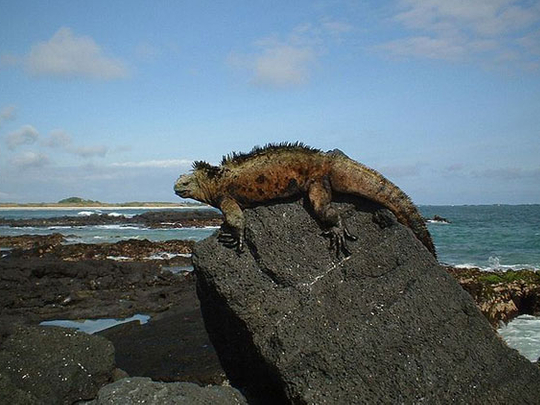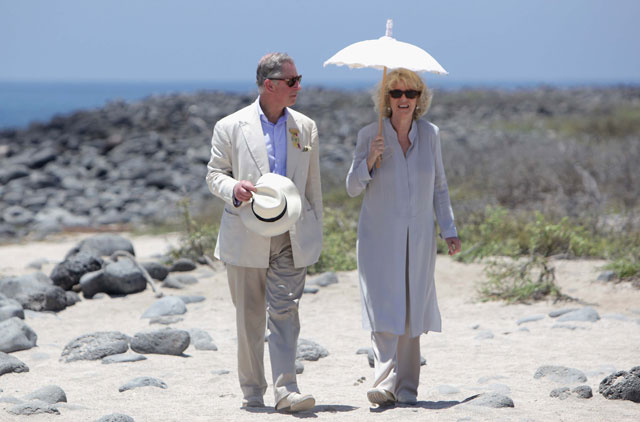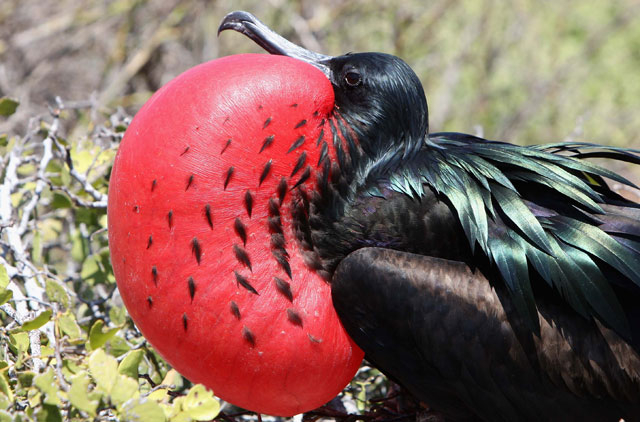
Lying in the middle of the Pacific Ocean, over 1,000 kilometres from South America's mainland, are the60 volcanic rock isles that make up the Galápagos Islands. While the black land masses are so inhospitable-looking that early explorers called them "an inferno on earth", the isolated Ecuadorian National Park has become a home for many one-off and unique animal and plant species; so much so that it was after a visit to them in 1835 that Charles Darwin became inspired to formulate his theory of evolution.
Comfortable creatures
While Darwin is the Islands' most famous visitor, it was in 1535 that they were first discovered by Spanish explorer Fray Tomás de Berlanga, who dubbed them the Galápagos after the giant tortoises he saw upon first arriving. These friendly giant tortoises - so big Darwin apparently rode one in the ocean - along with abundant seal colonies, colourful marine iguanas, birds, tropical fish and penguins mean this is probably the world's most unique nature park. There were just 15 giant tortoises left in the 1970s, a figure now up in the thousands thanks to ongoing conservation work; whilst the tortoises' island co-habitor, the Galápagos iguana, is the only one of its species that can live underwater. In fact, just having arctic and tropical creatures in one region is mind-blowing.
Perhaps the most amazing thing about the archipelago's animal residents is how calm and confident they are around humans - iguanas will bask in the sun while you stand just inches away, tortoises, penguins and seals will go about their day-to-day business while you look on and the many species of birds will hop around you with curiosity. The animal residents are famously friendly because they have been so isolated that they don't associate humans with danger in the way most creatures do - all of which means it's essential that visitors are respectful to the islands' inhabitants.
Cruise the islands
Before visiting the Galápagos Islands it's important to understand that it isn't an archetypal tropical paradise that boasts swaying palm trees and luxury loungers. Instead, it's a rocky, volcanic landscape that's a paradise for active travellers who want to hike, scuba dive and meet and interact with an assortment of charming and unique animals, and there's no better time to visit than now, towards the end of the warm and rainy season (January to June), before the dry and colder season (July to December). The temperature from May to July sits at a beautiful 23°C, and the period from June to December is when more animals are usually spotted (you'll even see humpback whales).
The only way to really see the islands is by boat, and there are plenty of companies that offer tours lasting from a few days to a few weeks. A reliable and friendly company to tour with is Galápagos Sub Aqua (www.galapagos-sub-aqua.com), whose Island-hopping four-day tour packs in the best the islands have to offer. On the first day you'll fly from Ecuador to the small island of Baltra before catching a boat to Santa Cruz, which is the home of tourism in the archipelago and boasts the area's most famous beach, Tortuga Bay, a long stretch of white sand that you'll share with iguanas, pelicans and turtles. The four-day tour takes you to places like the Charles Darwin Research Station; Sea Lion Islet, where you can snorkel with very playful sea lion pups; coves and cliffs; iguana colonies; tortoise farms; mangroves, where thousands of mockingbirds flit, and lava tunnels that boast stalactites and stalagmites.
Travelling in the Galápagos Islands is an active pursuit - and most tour guides say that if you're not in the physical condition to get in and out of a small dinghy then it won't be for you. But if you are, there's literally nowhere else in the world where you will feel as at one with nature.
Celebrity fans
“Some things really stood out about the experience,” Damages actress Glenn Close spilled of her trip to the islands. “First, we went scuba diving and we were clinging to part of a volcano and out of the blue we saw 22 sharks whizz by. Second, we followed an orca for about an hour in a little boat. To be that close to a whale was wondrous. We even saw him feeding on a sea turtle.”
Trip notes
Los Tuneles
This spot in-between islands is unique thanks to its volcanic arches - it looks like there are a series of natural bridges just rising up from the ocean. Go with a tour company that's prepared for snorkelling and you'll see rays, sharks and seahorses while you swim through the many arches and mini-tunnels.
divingthegalapagos.com
Pinnacle Rock
On the volcanic islet of Bartolomé Island, which has a total area of just 1.2 square kilometres, you'll find red, orange, green and shiny black rock formations, as well as the strikingly shaped Pinnacle Rock. Snorkel around the rock and reef sharks, turtles and penguins will definitely join you.
discovergalapagos.com/bartolom
Sierra Negra
The 16-kilometre trail to get there is worth it because at the end is the second largest volcano in the world. Try and go when there are clear skies as on a good day you can see the ocean, the active craters and lava tunnels when you get to the top.
tours-galapagos.com
Filmed there
Baraka, Master And Commander: The Far Side of the World (the first and only feature film to be filmed on the islands), The Galapagos Islands with Richard Dreyfuss.
Stay here
Budget: La Casa de Marita
This extremely colourful hacienda on the island of Isabela (which is often considered the least spoilt in the archipelago) has 19 rooms, a great restaurant and a convenient location just10 minutes walk from the island's main town. Oh, and it's right on a beautiful white sand beach. Rooms start from Dh450-a-night.
galapagosisabela.com
Mid-Range: Finch Bay Eco Hotel
With 21 standard rooms and six ocean-view rooms, this quiet spot (no cars are allowed) on the tourist-base island of Santa Cruz is eco-luxe. Everything is built from environmentally friendly materials, but you still have creature comforts like beach access, a pool, a jacuzzi, bar and restaurant, WiFi and a yacht at your disposal. They take bookings as packages, so book for four days and three nights and pay Dh5,000 for all meals, two full-day excursions and transfers in and out.
finchbayhotel.com
Luxury: Iguana Crossing Boutique Hotel
This gorgeous, modern but not ostentatious, hotel on Isabela Island gets its name because it is indeed right in front of where the famous Galápagos iguanas cross from the mangroves to the ocean. Known for its service, it's a great spot to visit if you want to be surrounded by nature but want to feel cosy in a very creature-comfort, indoorsy way at the end of a long day. From Dh1,000-a-night.
iguanacrossing.com
Fly there
American Airlines flies to Quito, Ecuador via London and Miami for Dh6,900 return, see www.aa.com. You can then fly from Quito to the islands with Aerogal from Dh1,600 return, visit www.aerogal.com.ec.











